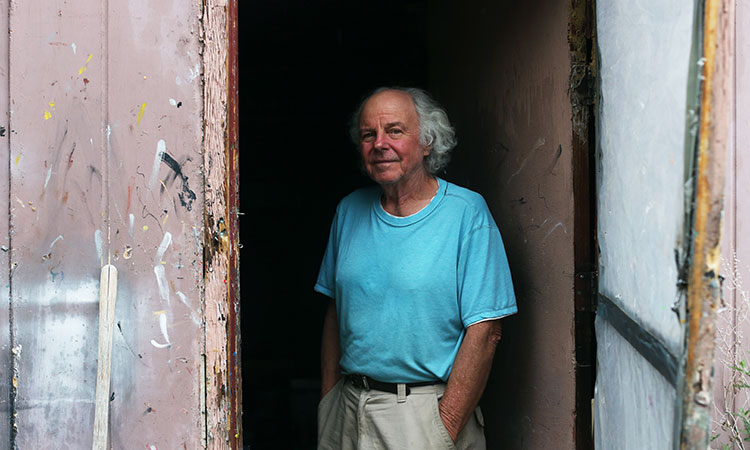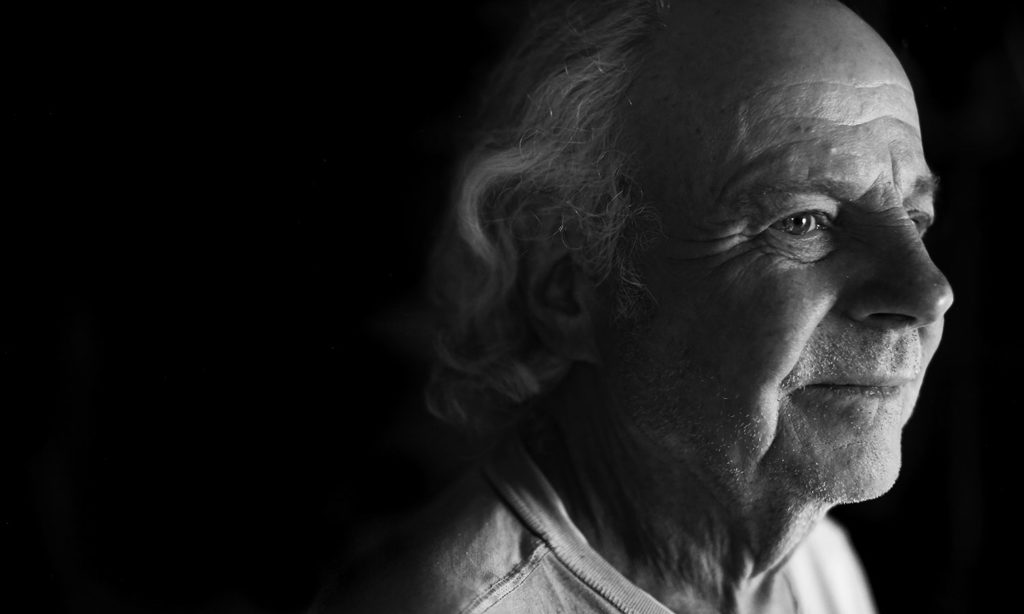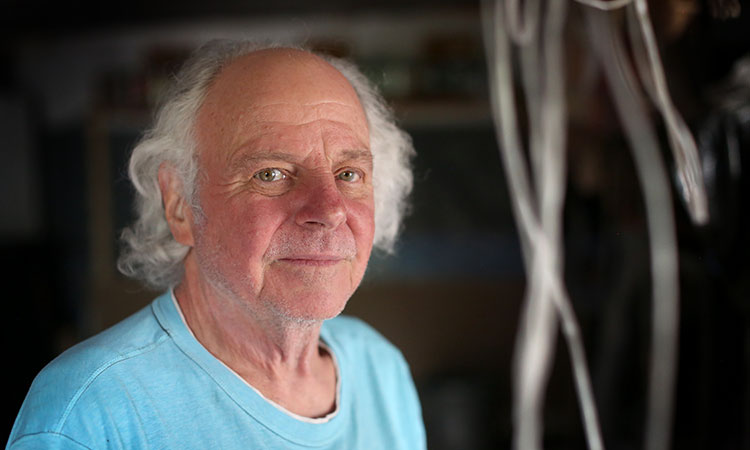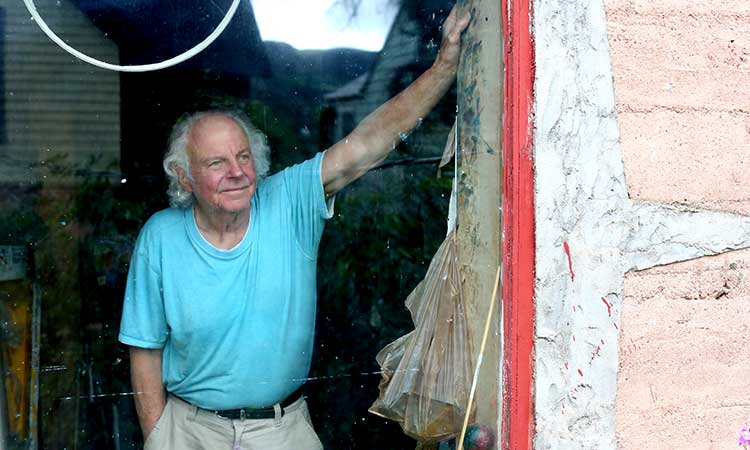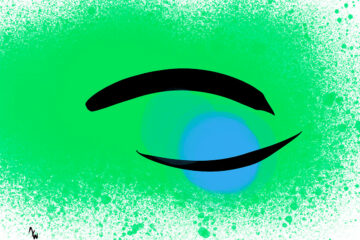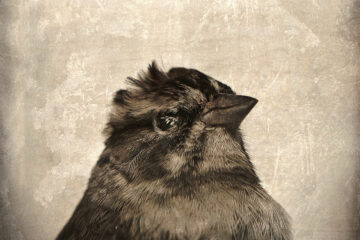Larry Kledzik has worked as an artist for going on 60 years. His art deeply intertwines with his philosophical perspectives. Sometimes viewers don’t know how to take in his work. Sometimes that touches some nerves.
Larry, 73, sat down with Humanitou and shined light on the processes and subliminal messages of his work, including those of his most recent exhibition, “HELEG,” which incorporated swastikas.
He reflected on his early days as an artist and cabbie in Chicago during the Sixties and Seventies. He shared his thoughts on the purpose of art, on legacy and ego, and where his art can go when he’s gone.
Meet Larry Kledzik.
Humanitou: You started painting as a teenager in the early Sixties. Did the cultural and political upheaval of that time influence your art and life?
Larry: I was interested in what I was doing. But you were in that systemically. You were part of it even if you weren’t thinking about it. It was a huge, huge thing that was happening and it pervaded society.
The Sixties, the Seventies, that whole cultural revolution was a huge, huge positive revolution that you were part of.
I wasn’t particularly thinking about it or identifying with any one section of it, like people did. I didn’t grow out my hair long. I didn’t wear beads. I didn’t mimic the Beatles. I didn’t even care about the music, but the music was everywhere.
I became a surrealist. The art was totalling consuming for me, so I was to the side of it, yet part of it. Looking back, you know you were part of a wave. It was like a wave that is still crashing on shore now.
And I was, a little later, at the Democratic National Convention down on Michigan Avenue. It was called a police riot.
My cousin and I would go down there and experience the tear gas and all first hand, and tried to avoid getting clubbed, but seeing people getting clubbed. Every night for a week.
But I was an individual. I didn’t feel like getting swept. My things I related to were the artists I was studying and the movements I was studying as an artist at the time.
Humanitou: I think that ties to where so many of us are now. We feel the anxiety and uneasiness of all this, whether or not we’re airing it out publicly. Was painting your profession then?
Larry: That’s all I did. I worked odd jobs, and I just became an artist. I did whatever I had to do to live. And living was easy in those days. You could drive a cab a couple days a week and have a four-room apartment to yourself.
You could walk down the street and there would be a sign, “For rent.” You’d go in there and the guy would show it to you. You’d give him the money. No forms, no papers. No complications. Hundred bucks a month, hundred-fifty, for a four-room apartment.
You could drive a cab. You wouldn’t have anything else, but you could pay your rent and have about enough for food. The perfect artist’s life. You don’t care. I didn’t even do laundry. I’d just have enough for food; I ate once a day. It was actually a great time.
Humanitou: I would imagine that driving a cab gives an incredible window into humanity.
Larry: Living in a big city like that and driving a cab, you’re all over that city in a way you would never be otherwise. You’re encountering every kind of individual. I had Hugh Hefner in my cab twice, on separate occasions.
You could go in there and get a cab anytime you want. You weren’t working for them in the sense that you punched a clock. You’d go get a cab and work eight hours or whatever you wanted to do. I worked for a couple companies.
I don’t know if it’s just beginner’s luck. Driving that cab I would bring in huge amounts of money, considering the hours I put in in my two days.
But driving the cab really started to wear on you. It got to be a drag. Depending on what else is going on in your life, the cab can be a depressing place to be.
You’re free, because you can drive down by Lake Shore Drive, pull in by the beach and go off the pier and jump in in the summer time, get your clothes soaked in that Lake Michigan water and get back in the cab soaking wet. You’d dry off in no time at all. I just started to make less and less money with it.
I once worked at a greasy spoon, too. Jobs like that. Until four o’clock in the morning. That’s real edgy Chicago, working in an area like that. It was pretty high energy. All of a sudden there’s a crowd and there’s a fight in the street, and people are going over cars.
It’s a real experience. I’m glad I lived there and had that experience, living downtown, because I pretty much grew up in the suburbs.
Humanitou: What is the purpose of art?
Larry: To me, it was a revelation. I read philosophy all through high school. I was a poor student. They didn’t have any philosophy courses. I would have been an A-student if they would have had philosophy.
That led me to art. In my junior and senior years, they had in the art department this Italian guy, a real Renaissance guy, who brought in a college-level Art History course. This was when I was really starting to dabble in paint. I took that and just gobbled it up.
I was reading philosophy, and it all relates. It was like the true world, like this is what the world is really about. To me, it was a revelation that put me in like a mild state of ecstasy all the time.
This opened up a world to me that I walked into and never returned from. It’s never gone away. I’ve never been able to step back across that line.
Humanitou: Your most recent installation, “HELEG,” touched some nerves because of its subject matter that included strong symbols: the hammer and sickle, and the swastika. You have a history of work that stirs conversation. Some call it provocative.
What is your intention with your work? And how do you receive the reactions — including criticism and confusion, even anger — to your work?
Larry: HELEG is a good example in that it generated a fierce dynamic that usually is lacking.
I consider my primary audience the general public. They seldom show up for the performance, but that’s OK. Whether they come or not, you don’t have control over that.
In this case, with this exhibit, I touched a nerve or something that is getting a response from different areas of that general public. I consider that more of a success than usual. Usually, my successes are subliminal.
I’m working on a subliminal process here that’s parallel with society itself. It’s happening with society. That is a process that is sort of intestinal. It’s part of both art and life working together. And I’m doing that.
A lot of people don’t see what I’m doing. You can’t expect people to see what you’re seeing when you’re doing your art. How it works with society is a crapshoot how that’s going to go.
There’s always someone that connects in a way that’s satisfying to me, and sees it in a way that can’t be like I’m forcing them to see it, or telling them what to see.
Humanitou: I don’t think you’re suggesting that creating controversy is your goal, your measure of success. Can you elaborate on that?
Larry: I actually hold back. If I wanted to be provocative, when this thing [HELEG] started to go public, I would have put on a uniform and a mustache, and would goose step in front of the place. And soon enough the police would be there and I’d have all the news. That’s provocative.
That’s what Maurizio Cattelan does, the Italian artist. Very provocative. Makes millions of dollars on his pieces. That’s provocative, and I have plenty of provocative stuff.
And there’s good reason to do that if you have a strong enough thing that you’re trying to get across. It might be a social issue. It could just be your ego. Cattelan’s both.
Humanitou: So, you’re not trying to provoke for the sake of provocation. Yet some people feel provoked and struggle to take in the work in any other way. What was your intention with HELEG?
Larry: The fact is, the symbols I used are provocative. I need to use them because they are my subject matter. How can I do my thing without using my subject matter?
If I’m going to use this subject matter, I’m going to use it in its pure form as what it is, as a symbol. And I’m going to transform it with certain materials, which I did.
I wouldn’t paint a swastika. I had to do something with it in a way that has to do with the central message that this stuff is buried in our consciousness. It’s buried in our culture.
Humanitou: And so you cut the shapes out of recycled wood panels to use negative space to highlight how the symbols exist in the woodwork of society, in our collective psychology.
Larry: Right.
Humanitou: When you leave it completely to the viewer to interpret, it can be risky, at least with controversial visuals like swastikas.
Larry: I’ve always approached things this way, even in my paintings. There’s always this hidden thing. There’s a hidden poetic essence in the subject matter that isn’t open to a literal translation. You kill it when you go literal.
So, you’re finding a way through technique or presentation to make that available, so that someone can see it. You’re pulling subliminal essences. I call it poetic content.
Poetic content is something that has a meaning that transcends a lot of mediums and subjects. The only way to approach that is obliquely, through the back door or around the side.
The person standing in front of it may not see that, but they may start to see it and be able to follow it, and see what you have evoked there.
Nothing would have stopped the responses (to HELEG). That’s the nature of this thing. What’s not being addressed in society is a total confusion. It’s out there on the stage. It’s right out there. It’s in the White House, in the news. The Nazi thing is right out there.
And people are in this sort of stunned state, trying to just hold onto their tropes and their own ways of thinking, which is all falling apart now. This is serious. This presentation matches the reality that is right outside the window.
So, why should I try to soften it? I can’t soften what’s out there.
Humanitou: Do you feel misunderstood as an artist, as a person with a particular philosophical view of the world?
Larry: No, I don’t. If people would misunderstand, they’d at least have a starting point. Usually, it’s just obfuscation. There’s a feeling of obfuscation, but that’s everything. Nothing is understood completely.
Everything in society is like a huge hodge-podge of confusion. All the issues. All this stuff that our society, supposedly one of the most rational societies in the world, things that should easily be solved, are obfuscated.
And it’s intentional obfuscation, because it’s in the nature of our current population of people in the country, and always has been to some extent. Until they’re seriously in trouble and have to start to think, they don’t. And we’re all like that.
They like to be comfortable. Until it gets uncomfortable, they don’t act — and then they act in the wrong way. They don’t solve the problem; they make it worse.
I can’t imagine how this country is making all its problems worse when it has all the resources that could make it better. That’s human nature.
So, provocative? These symbols are provocative in themselves. I’m using them. I’m not trying to be provocative. I do enjoy the fact there is a power dynamic going on with this that actually is touching the society that’s doing this. It’s my society that these things are about.
It’s an investigation into these symbols and where they originated in philosophy. If I just said that, people would yawn.
Humanitou: What are your thoughts on the legacy of your life work as an artist?
Larry: I’ve learned to live in the present and not project my self-worth. If I die and my art has only gone this far, that’s really fine. It’s operated in a realm of worth that I find extremely satisfying, and I think it’s valuable.
You can get desperate to preserve, but I’m going to preserve what? I’m nothing. I’m just a person like anybody else. I did this. Whatever it does, it’s going to do.
If it’s saved, it’s saved. If they just take it all to the dump, so what? It’s a lot of trouble to keep artwork.
And it’s a lot of trouble to maintain a reputation, once you have it. The fame, or worrying about that, is an egotistical thing. It’s part of the small ego.
There’s the big ego, which expands out into the universe and gives you a sense of joy. And the small ego, where you’re worried about your personal things or your welfare. I want to live joyfully as long as I can.
This is it. Right now is it, if you can at least have enough balance to enjoy it, because it’s hell to struggle.
